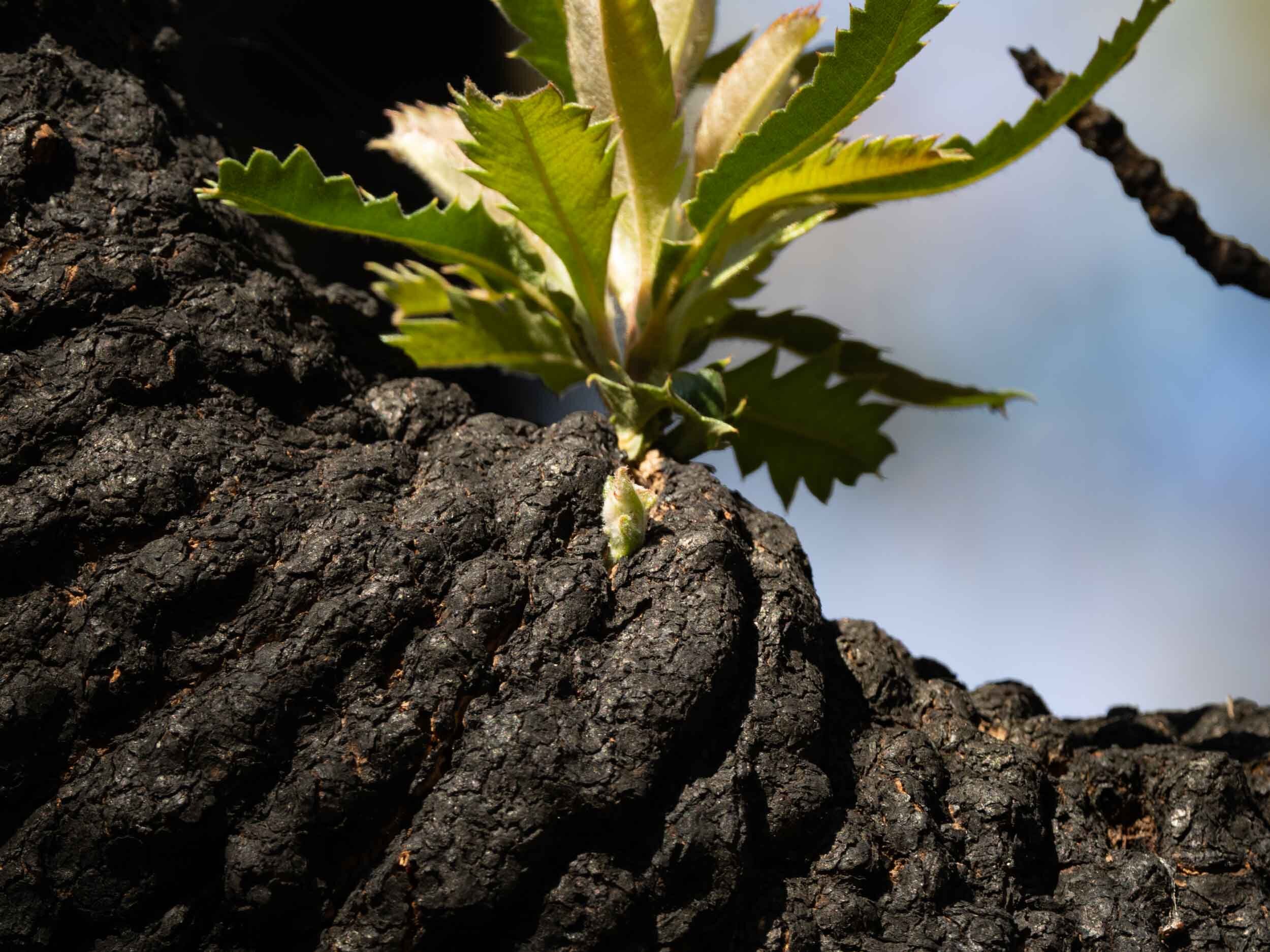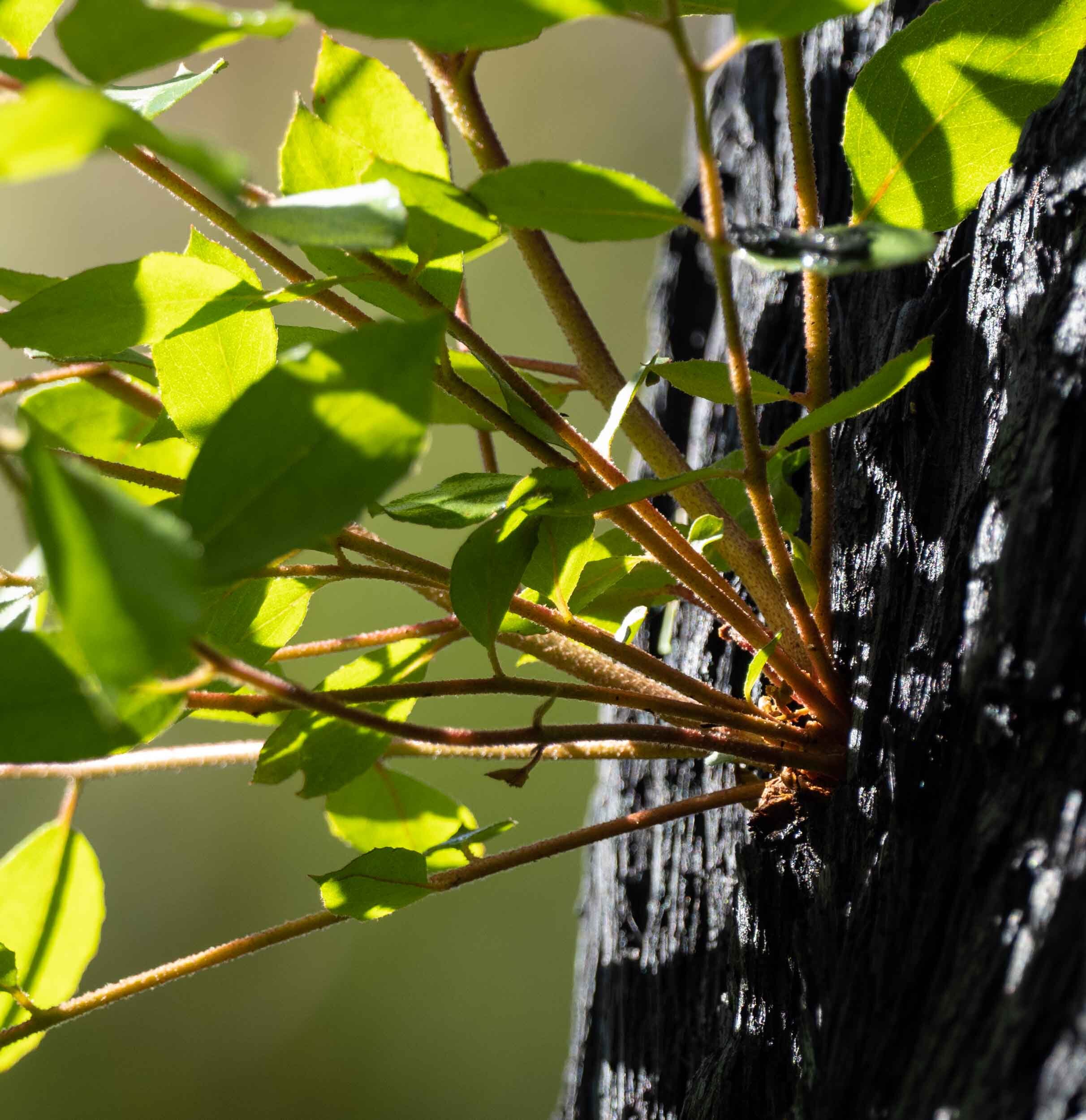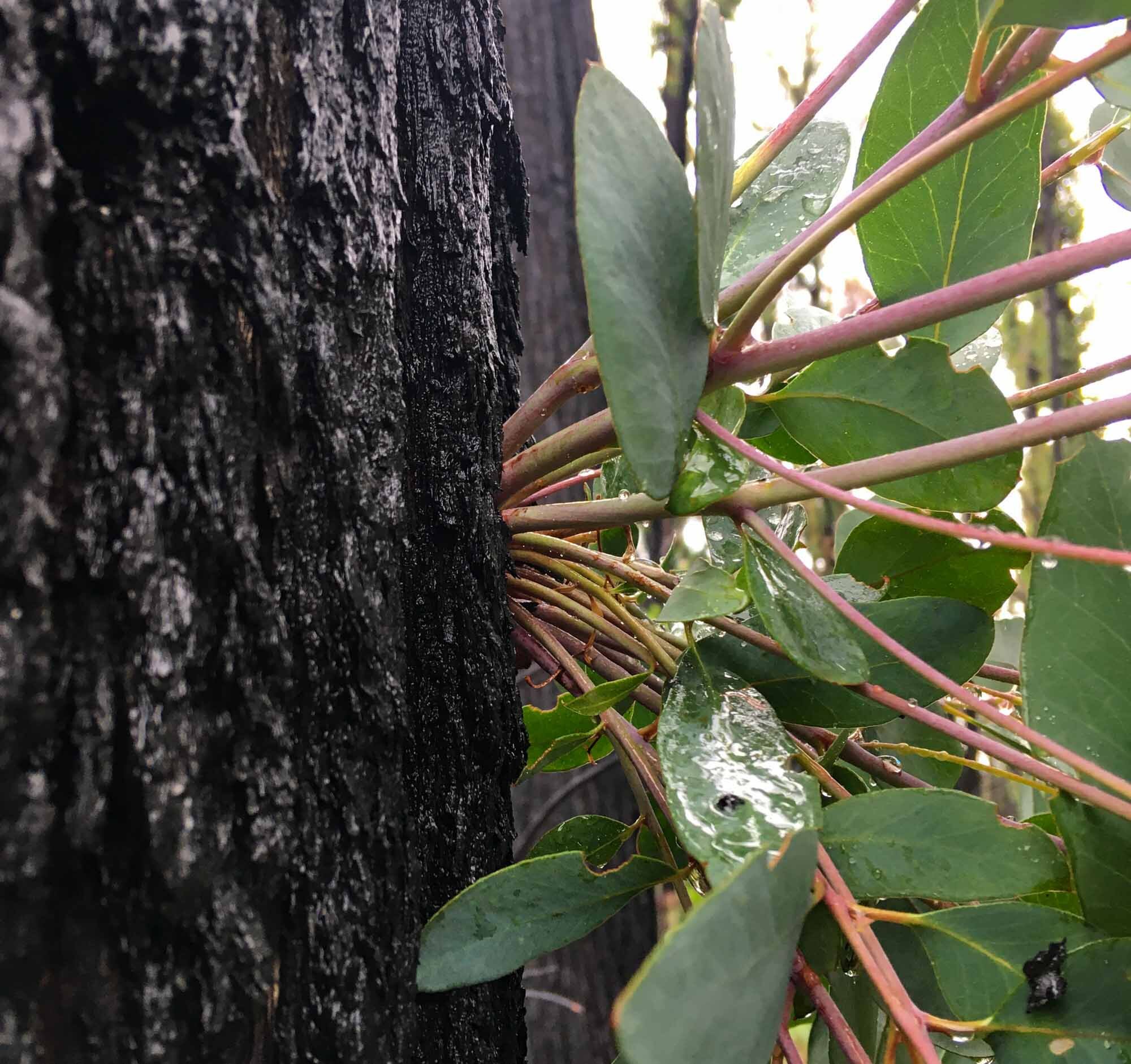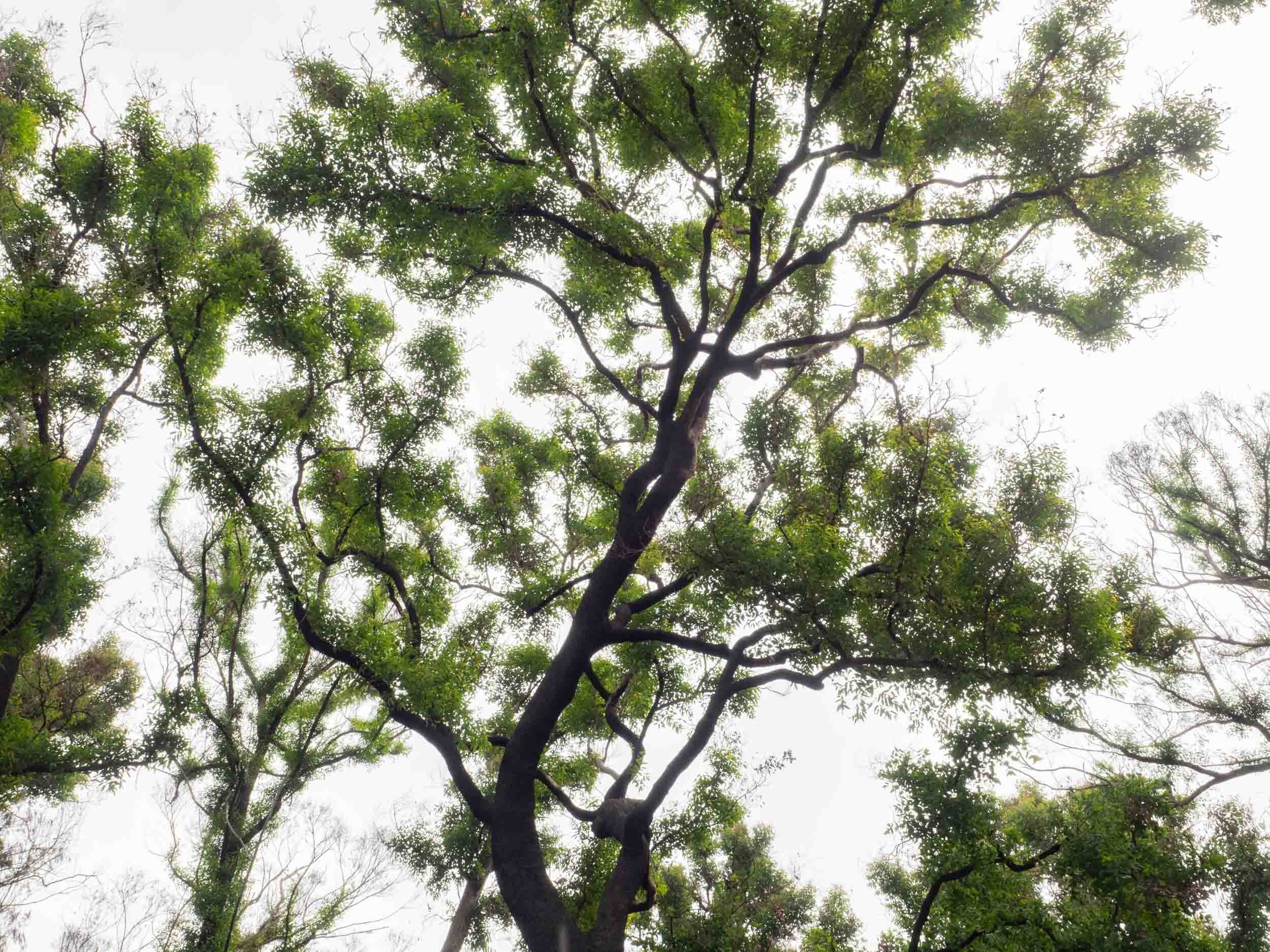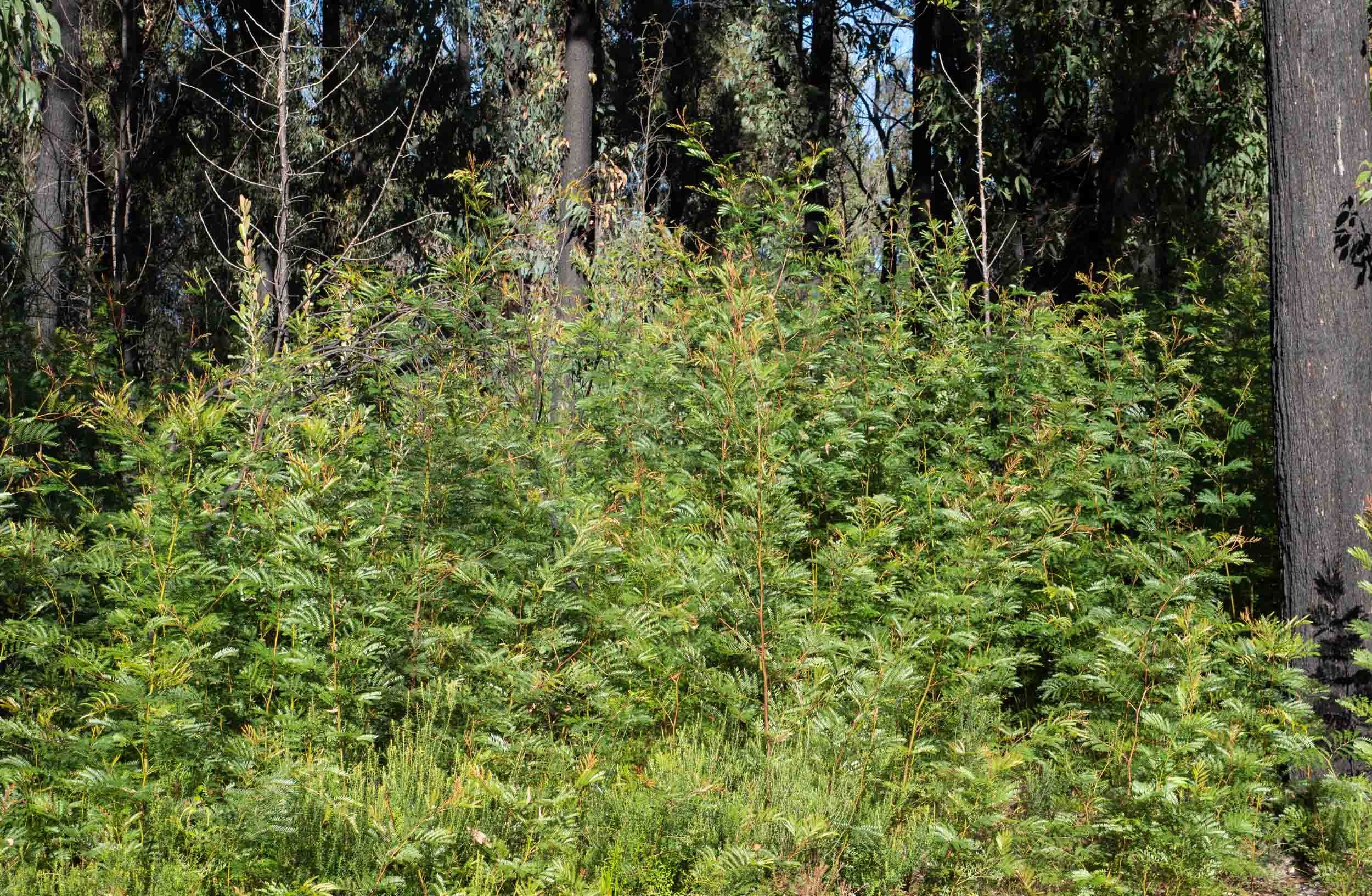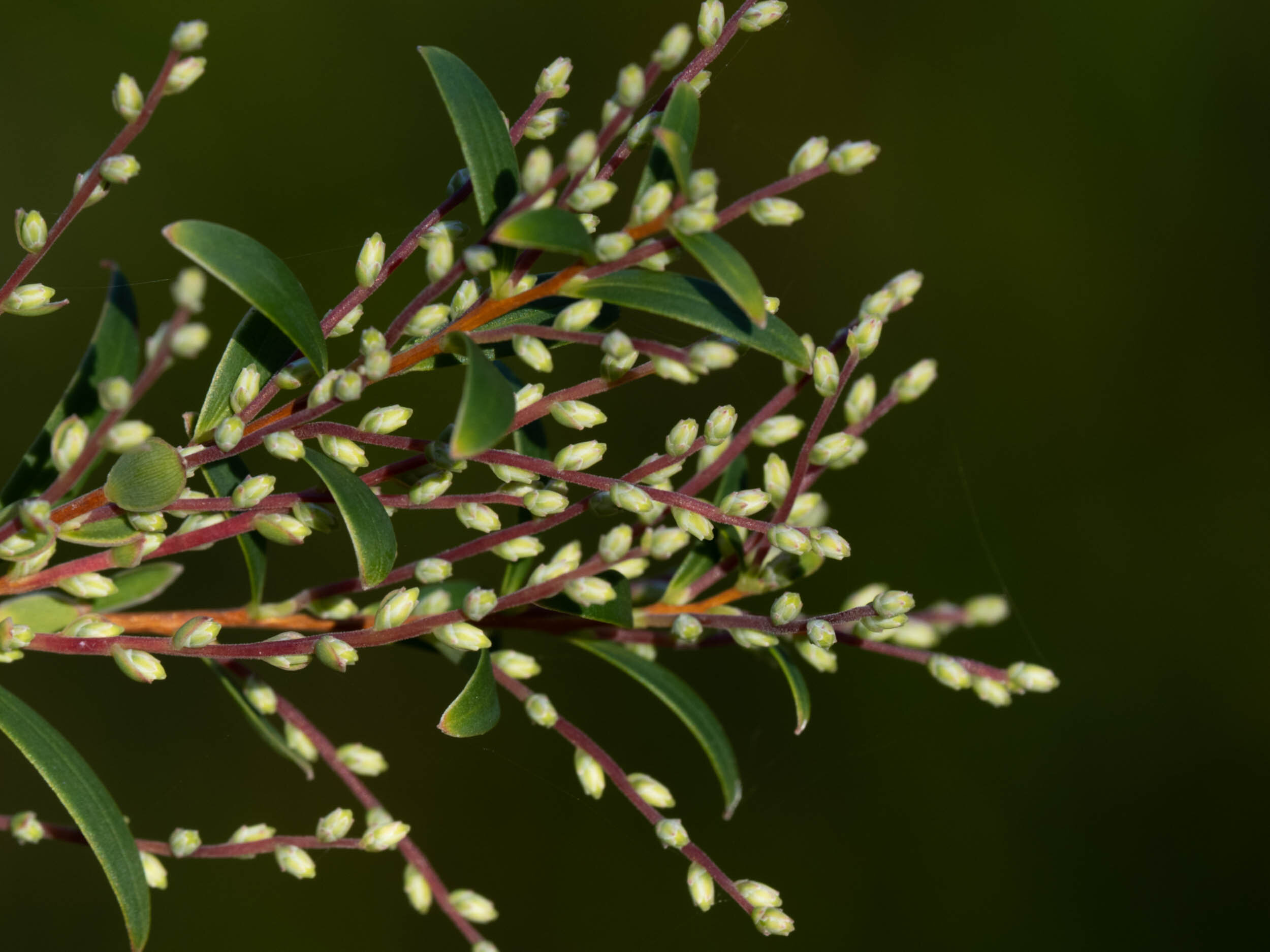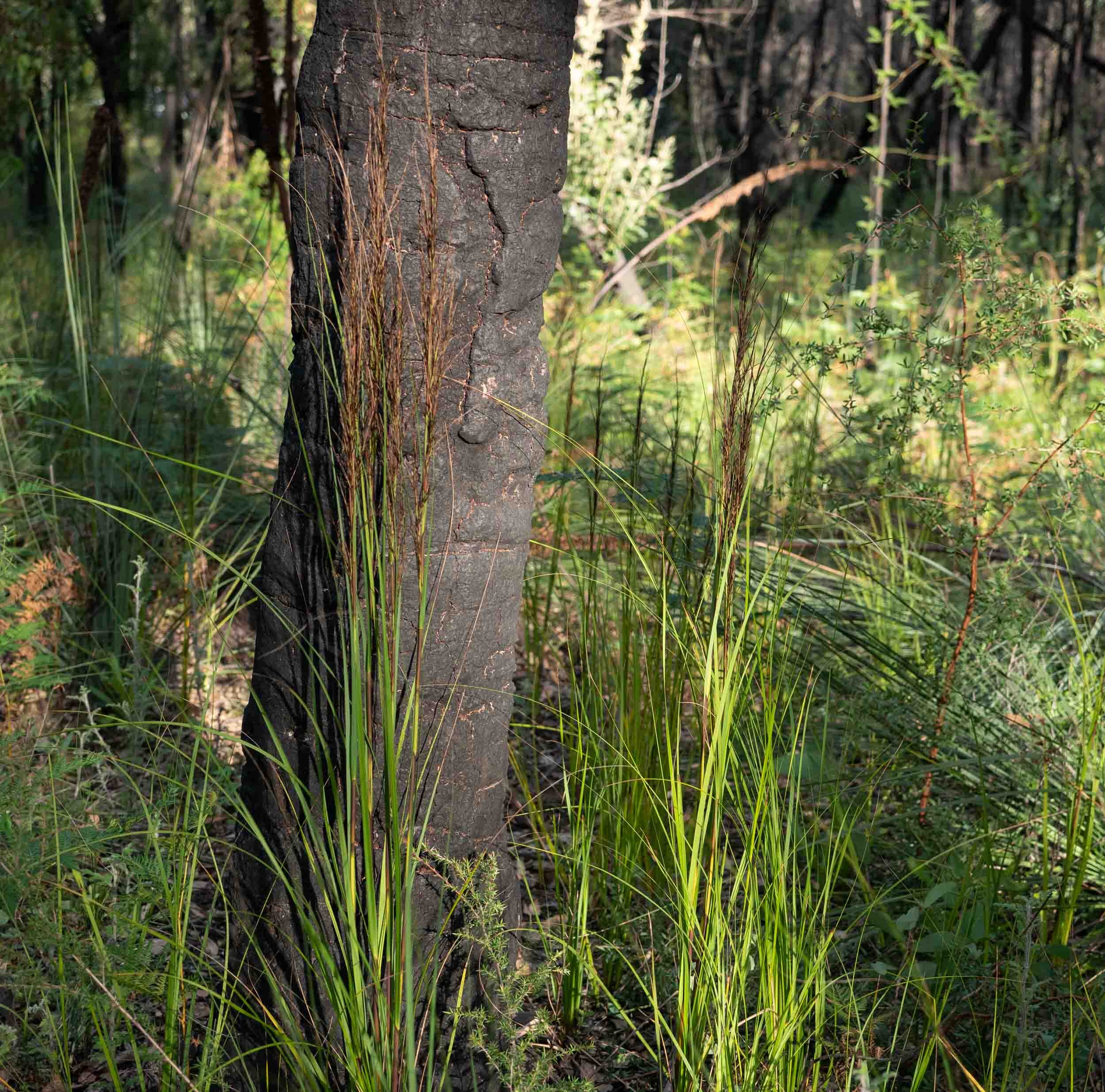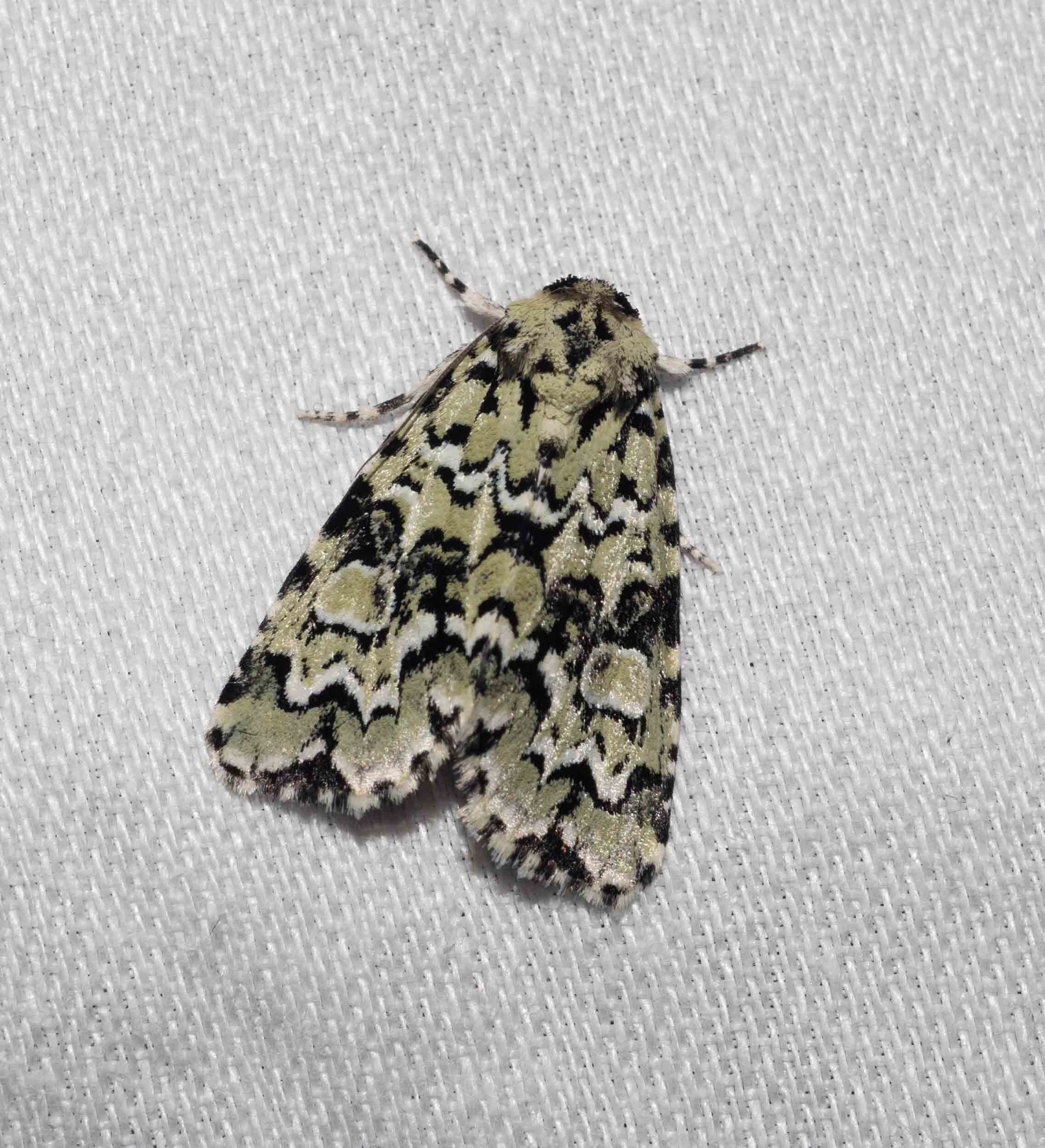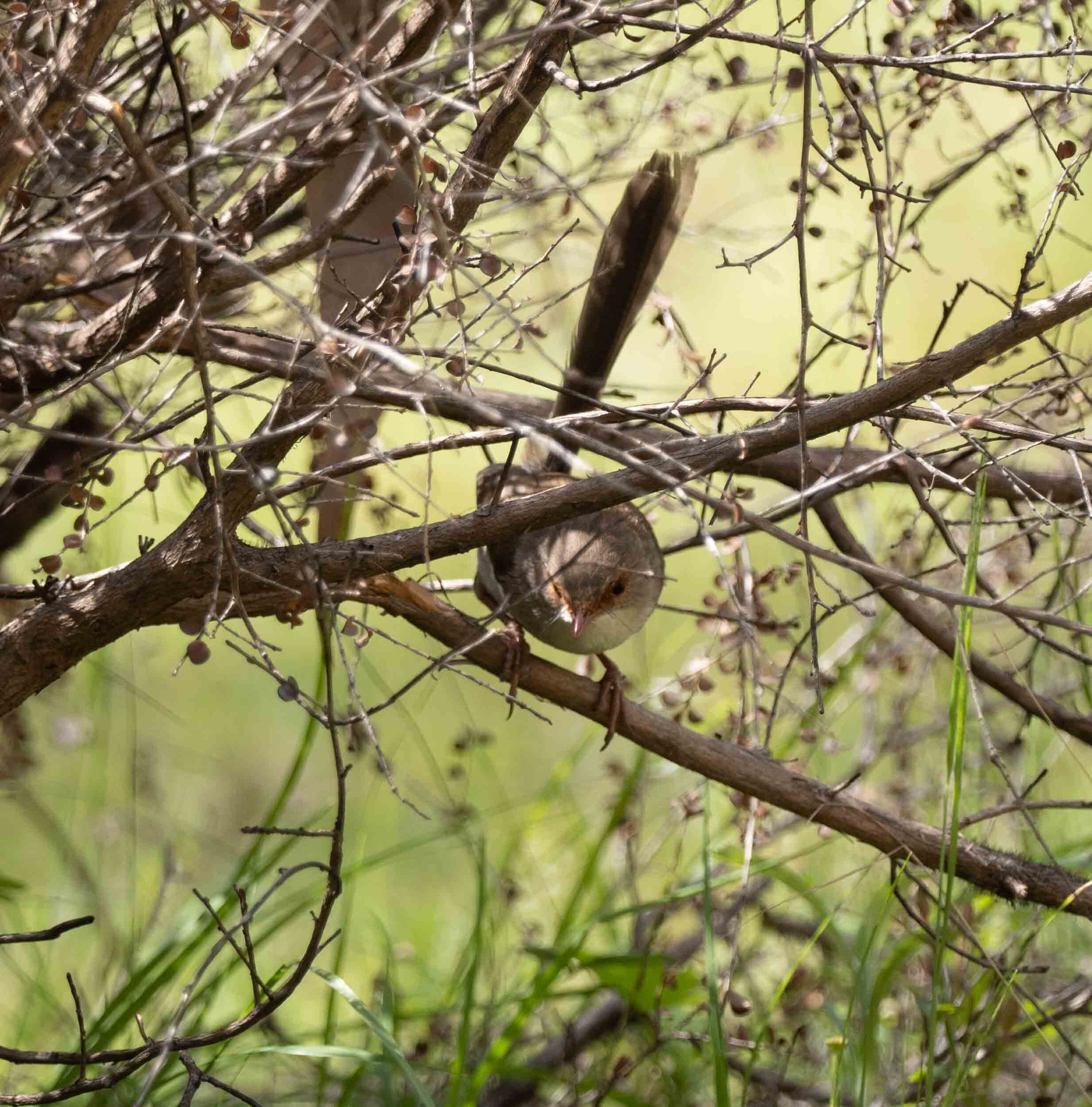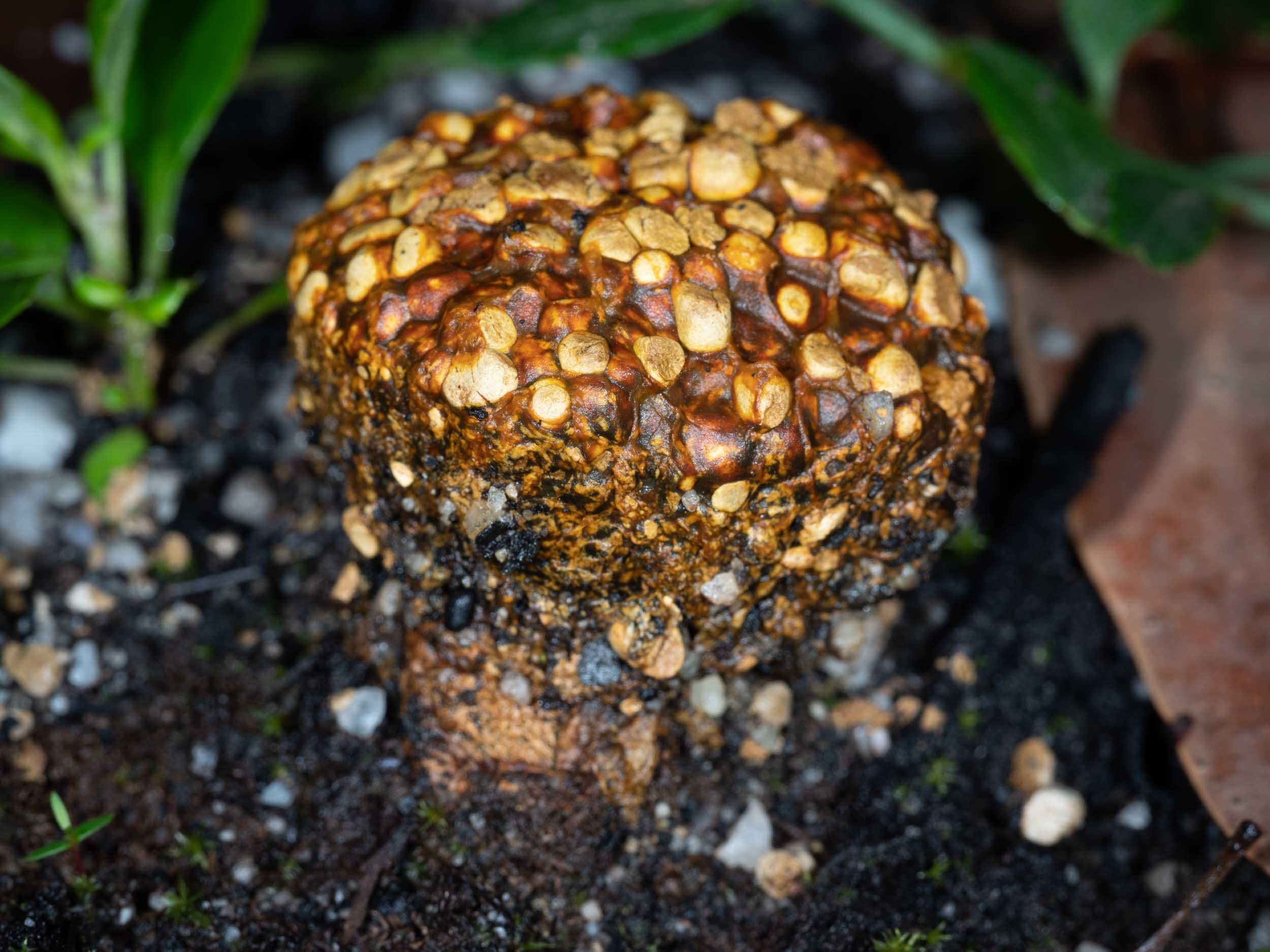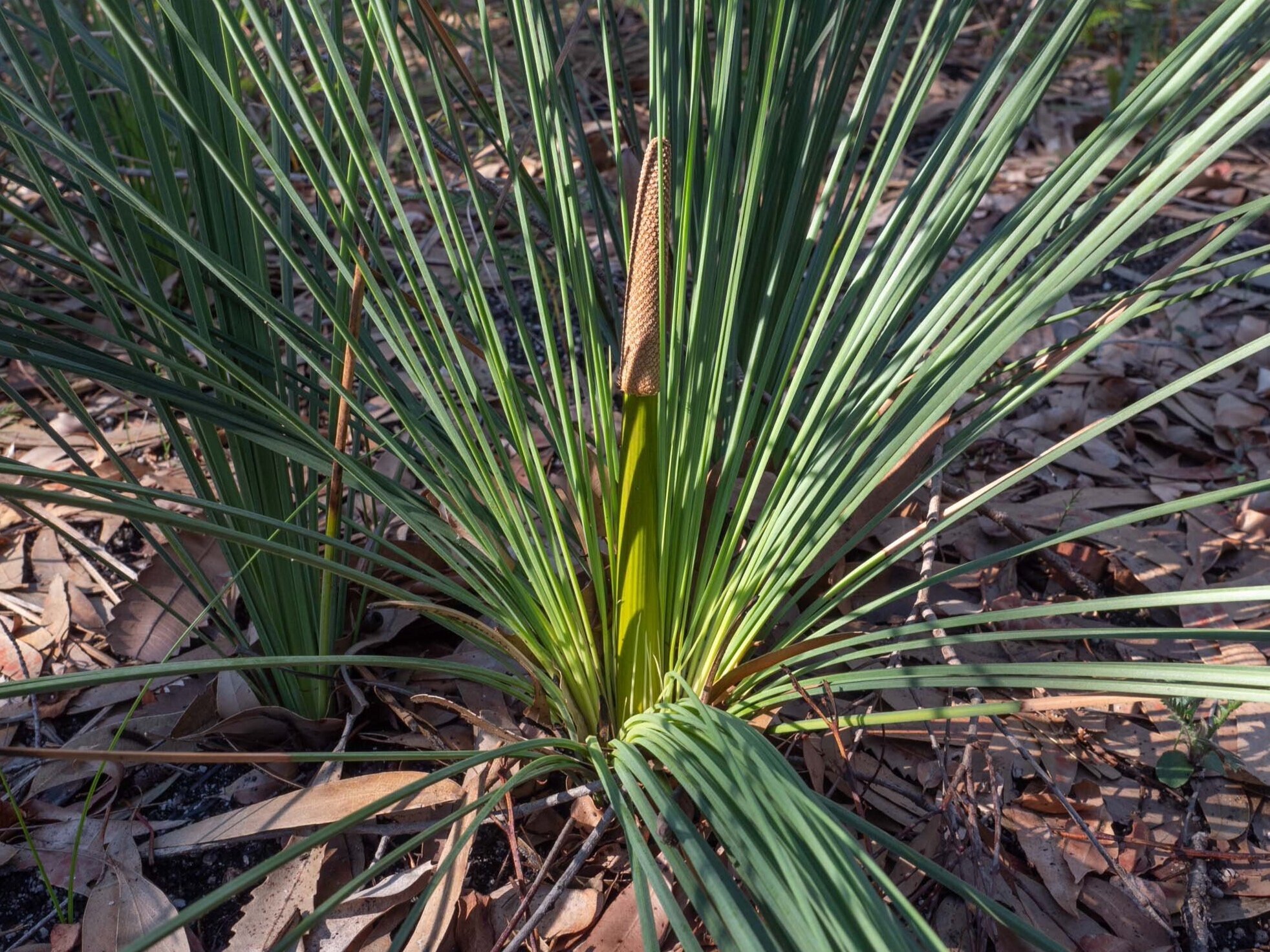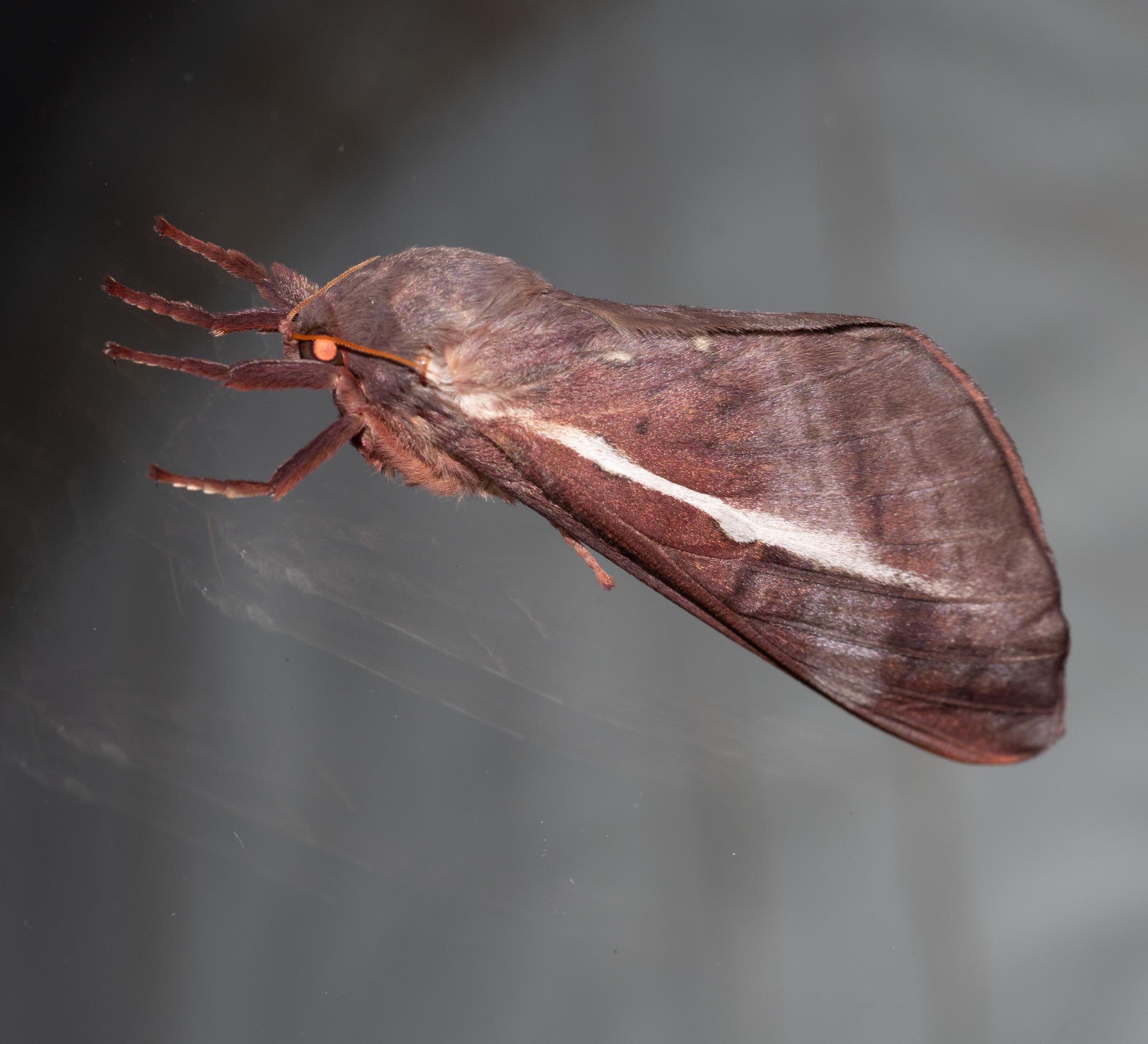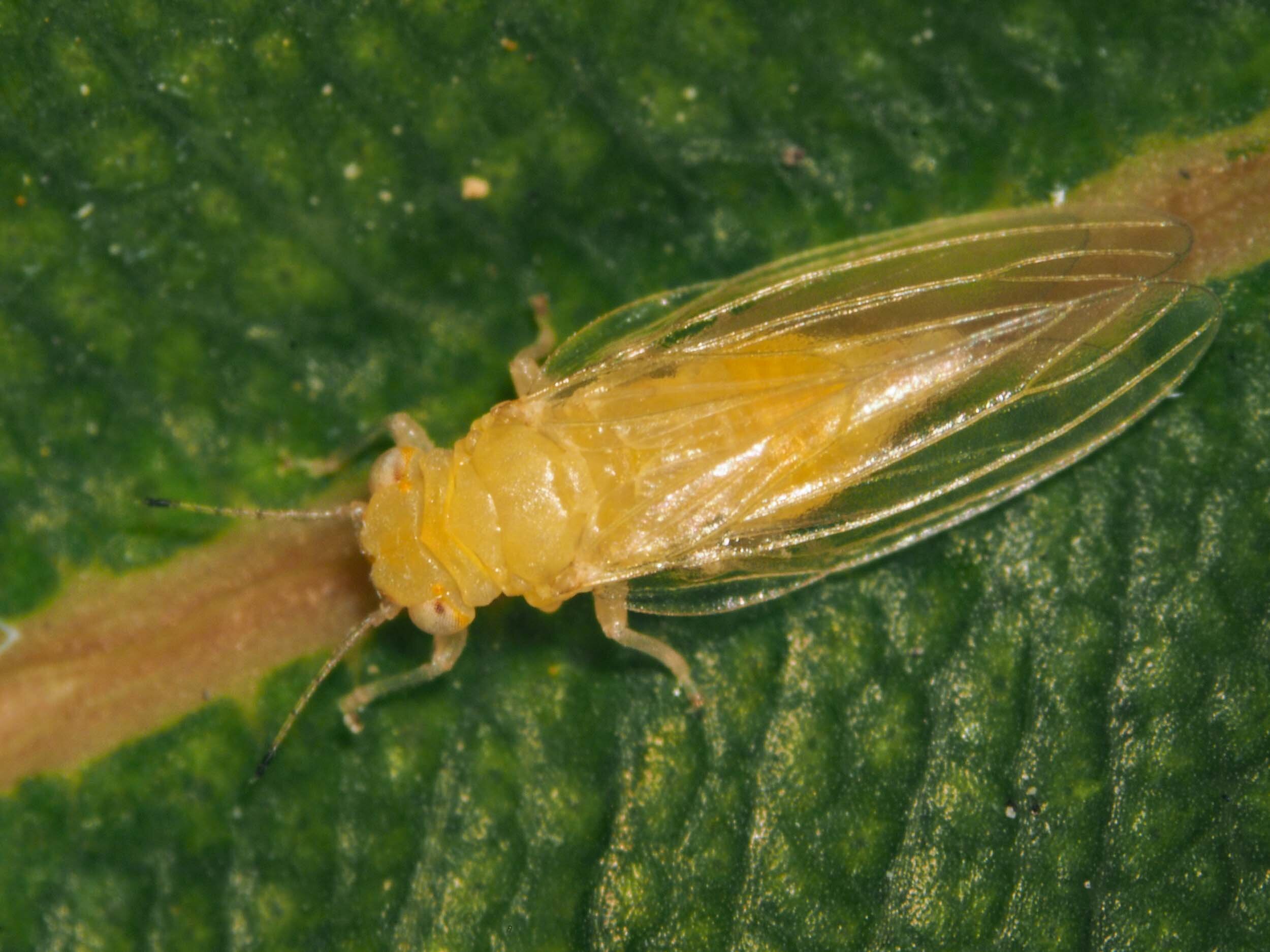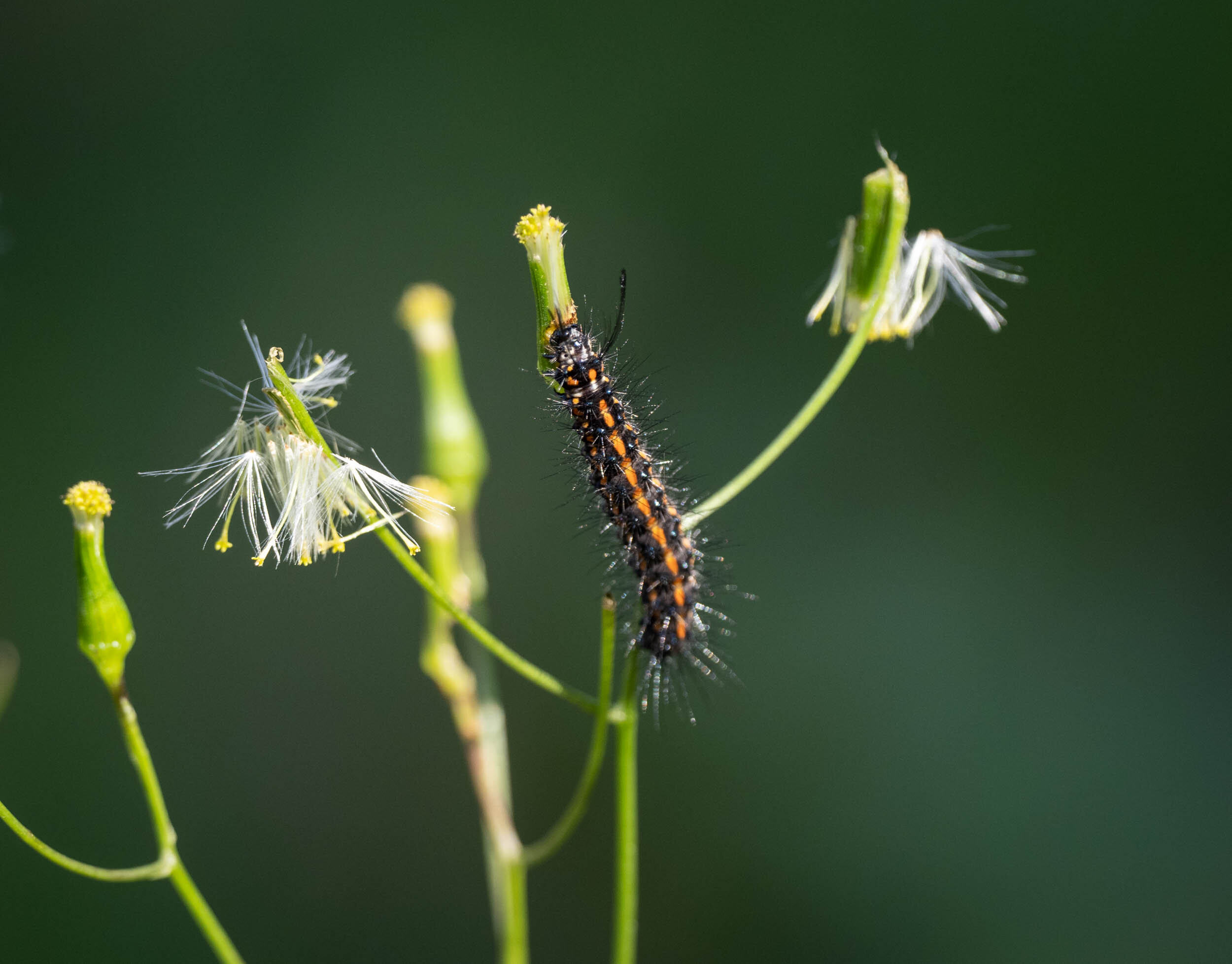Understanding fuzzy trees

Anyone who has travelled through eucalypt forests a few months after a bushfire will be familiar with fuzzy trees. You know, that pipe cleaner appearance of blackened trunks and branches with their short tufts of bright green leaves?
This remarkable landscape raises many questions. What kinds of trees do this? Will they ever regrow proper branches? Why is it that some patches of forest are very fuzzy but others are not? And why is it that some look to be sporting a barber’s pole spiral of fuzz?
The fire that burnt through our forest on 5th January 2020 was a high intensity fire.
High intensity fires result in total crown scorch or consumption (Burrows, 2013). Vegetation on the ground and in the mid storey burns and flames run up rough-barked trees. Some upper branches ignite, but most leaves are simply killed by the radiant heat and rising plume of hot gases. Living cells can’t cope with temperatures much above 60ºC.
11th January, 2020 (1 week post fire)
Ecological studies of the effects of forest fire refer to the ‘fire trap’. This is the vertical zone within which heat kills the above ground parts of most saplings and shrubs. Low intensity fires – such as hazard reduction burns (ideally!) – have a much lower fire trap.
Heat rises, so subsoil vegetation is protected. Just 1-3cm of soil can be enough to protect subsurface vegetation from even the hottest fire.
The canopy of our home forest was completely scorched. Based on the 5-point fire severity scale applied by Meier et. al (2012) in their study of forest fires in Australia’s south-east, our fire rated as a 4 across most of the site – “understorey foliage burnt and tree canopy scorched (Canopy Scorch)”.
It could have been worse. There is a higher severity rating – “5, understorey foliage burnt and tree canopy consumed (Canopy Consumption)”. Perhaps the fact that our fire struck during the relative cool of the night saved the canopy from total consumption.
Three months on and the big news is that nearly all of our large trees are alive! Of course, some large trees fell during the fire and completely disappeared. But of those that remain standing, very few are dead.
The sepia tones of blackened bark and scorched leaves are being painted over in many shades of green. Soft leaves cloak the branches and trunks.
For the record, and to the best of our knowledge, the last time this forest burned was forty years ago.
Understanding meristems and plant growth
I’ve been doing a bit of reading. To make sense of this regrowth, I first needed to revise some basics of plant anatomy and development.
Trees and shrubs grow from the tips. Patches of actively dividing cells at the end of the growing stem leave new cells in their wake, and these new cells differentiate into the various tissues of the plant. This patch of cells at the tip is called the apical meristem. (Meristem simply means a patch of undifferentiated cells that are capable of dividing and forming a variety of tissues and organs).
Plant shoots have several types of meristems, groups of cells that can divide and thereby produce the new tissues and organs as the plant grows.
Secondary meristems form in leaf axils. At regular intervals behind the growing tip, a group of newly formed cells will be set aside and these will differentiate to form a leaf plus a small cluster of meristematic cells - an axillary meristem. Some of the meristematic cells form an obvious bud (‘axillary bud’), but others remain beneath the surface of the stem. Chemical signalling determines whether the buds continue to develop or whether they ‘sit and wait’ in a dormant state.
Axillary meristems can become active in response to loss of the apical meristem. Gardeners commonly use tip pruning as a way to create a bushier plant. By removing the apical meristem they disrupt the chemical signals that normally inhibit the meristems lower down. Although the chemical pathway responsible for communication between the apical and axillary meristems is more complex than once believed, it does involve ‘auxin’. Auxin was first described 100 years ago and is a plant hormone familiar to students of botany. This phenomenon is generally described as ‘apical dominance’.
Once activated, an axillary bud grows to form a branch in just the same way as the stem developed – with its own apical meristem and subsequent set of secondary meristems.
Dormant axillary meristems remain under the bark. As a stem develops, cells of the vascular cambium and cork cambium divide laterally and therefore the stem thickens. It becomes a trunk or branch. It sheds its leaves and develops bark. But many of the axillary meristems remain. These are now called epicormic buds or epicormic meristems.
Epicormic growth can be triggered by plant damage. Damage to the crown of the tree can activate the epicormic buds. The result is the development of a new shoot which may ultimately thicken and become a branch.
Many types of woody plants have epicormic buds. Deciduous fruit trees are a well-known example, resprouting from these ‘nodes’ in Spring.
(Why ‘epicormic’? It means ‘above the corm’. The term epicormic growth distinguishes those shoots that form along the trunk and branches from those that arise at the base, from the ‘corm’. The corm is the swollen base of the stem, usually just below ground. In many woody plants the corm is the site of a large number of secondary meristems and is called a lignotuber. The distinctions become meaningful for ecological studies of post-fire resprouting).
Lignotubers protect meristems from fire. There’s a good reason that after fire so many trees and shrubs resprout at the base. The meristems of the lignotuber are underground and therefore protected from heat, unlike the above ground epicormic buds.
Eucalypts are epicormic marvels
Despite the fact that many tree species have epicormic buds, very few are able to produce epicormic shoots after high intensity fire. It really is a eucalypt speciality (Burrows, 2013).
The eucalpts include hundreds of species across three genera: Angophora ( about 10 species), Corymbia (about 100 species) and Eucalyptus (about 750 species). They are almost entirely Australian and they are the dominant trees of most Australian landscapes.
Every one of the seven eucalypt species in our home forest is producing epicormic shoots.
In fact, nearly all eucalypt species resprout in response to high intensity fire. The shoots may be above ground (axillary or epicormically) or from the base of the trunk (Burrows, 2013).
In eastern Australia only nine eucalypts are unable to resprout after fire (Nicolle, 2006). That is a tiny fraction of the hundreds of Eucalyptus species native to the region.
Alpine Ash (E. delegatensis) is one tree that cannot resprout. It must therefore rely upon seeds for regeneration. Such obligate seeders are particularly vulnerable to short fire intervals as the replacement trees take decades to mature and to, in turn, replenish the soil seed bank.
Basal sprouting from a young E. cypellocarpa. All the above ground parts of the tree were killed. The stem diameter is just 7cm.
So what’s so special about eucalypts?
It’s not just the bark …
Thick, insulating bark can protect epicormic buds and the vascular cambium from high intensity fire. This is a strategy employed by many trees and shrubs in Australia, not just eucalypts. The papery layers of insulating bark of Persoonia linearis and Persoonia levis are excellent examples, as is the very thick bark of Banksia serrata.
Eucalypts have a wide variety of bark types, including smooth, fissured, fibrous and corky. The published information on bark thickness is rather limited. However, a study in northern Australia reported eucalypts with thinner bark than neighbouring trees – but they grew taller, faster (reviewed in Burrows, 2013). In a forest, height is generally a good thing. A tall shrub or tree escapes the shade of neighbouring plants, and if it’s tall enough it may also escape the fire trap of low intensity fires.
So although bark does play a role in fire resistance among eucalypts (Meier, 2012; Burrows, 2013), it’s not the prime reason for their extraordinary post-fire success.
… it’s the epicormic strands! A eucalypt speciality.
Eucalypts have evolved a specialised mechanism for ensuring the survival of their epicormic meristems. They have ‘epicormic strands’ – radially oriented strands of tissue that extend from the surface to deep inside the trunk (Burrows, 2013).
Contrasting the effect of bark destruction upon the isolated epicormic buds of most trees with the epicormic strands common among eucalypts.
Even when heat penetrates quite deeply into the trunk or branch, the more internal cells of the strand survive. Only if heat reaches the vascular cambium is the branch or the tree killed.
In addition, each strand consists of multiple strips and so can produce multiple buds from a single point. This explains the very bushy nature of eucalypt epicormic shoots!
What about those spirals?
This whole journey started with me pondering those barber’s pole spirals. They’re not always obvious, but they are real. The epicormic sprouts trace a spiralling pattern up the trunk. And now I think I understand why.
As a young plant stem extends it naturally spirals. Such ‘phyllotactic spirals’ are one of the fundamental patterns of nature. They have fascinated biologists and artists for centuries.
So as the stem grows, the arrangement of leaves reflects this spiral. And so do the axillary buds. And therefore epicormic buds. It all seems to make sense when you think of the early development of the sapling. Neat!
Of course, I’m making a logical leap here, but for now my curiosity is sated.
Spiralling epicormic growth on a large Eucalyptus cypellocarpa (Mountain Grey Gum).
So what happens next?
What are the next steps in the development of the forest? Here are a few predictions.
Branches will form
It is normal for trees to grow new branches. When an older branch is diseased or damaged, epicormic growth nearby gradually replaces it (Meier, 2012). The same is true after fire. Some of the post-fire fuzz on our eucalypts will lengthen, thicken and form new branches. It’s likely to be the uppermost shoots that do this. Many of the epicormic shoots will simply fall away, particularly the growth on the trunks.
Leaf shape will change
Juvenile leaves of eucalypts are usually quite different to the mature leaves. Epicormic shoots produce juvenile leaves. Over time, newly formed leaves will increasingly resemble the mature form. The juvenile leaves of the early sprouts will be shed.
Blossom and new seeds are a way off
Young eucalypts are often several years old before they flower. Similarly, the new, post-fire foliage will go through a ‘secondary juvenile period’. We’ll have to wait awhile before the trees attract hordes of nectar feeding insects once more. For example, Eucalyptus sieberi is reported to have a secondary juvenile period of four years!
The canopy will recover
Despite the extensive fuzz on the upper branches of the Angophora, there is still a lot of sky showing through the canopy.
Angophora (middle and right) provide the early makings of a canopy.
In areas without Angophora there is even more sky. Over time, this will change. More branches, more foliage, and the forest floor will again have more shade.
In the meantime, seedlings and basal resprouters will take advantage of the extra light.
The ability to rapidly regenerate leaves well above ground enables eucalypts to maintain their competitive dominance in the forest ecosystem. They will again steal light from plants of the lower storeys.
Some more trees will die
Most of the large trees will continue to survive – but not all. Many have sustained damage at the base of the trunk and in some cases this damage will be lethal.
Such trees are likely to fall before too many more years pass. Perhaps a strong wind will do the deed. Some basally-damaged trees may become top heavy, weighted down by lush growth wet with rain. In the meantime we let them stand. They will continue to be home to various animals and provide hunting perches or roosts for owls and other birds. None of these trees are particularly dangerous to us. We’d have to be very unlucky – standing in exactly the wrong place, at the wrong time.
A more significant threat to the forest is fire. Should we have another high intensity fire too soon, many more trees will die. The large eucalypts need time to recover and regrow. They need time for their bark to thicken and for their crowns to redevelop. Importantly, it will take years for the forest to rebuild its canopy seed bank.
Of course, we will continue to track and study these forest changes over the months and years to come.
References
Burrows, G.E. (2013). Buds, bushfires and resprouting in eucalypts. Australian Journal of Botany, 61: 331-349.
Collins, L. (2020). Eucalypt forests dominated by epicormic resprouters are resilient to repeated canopy fires. Journal of Ecology, 108: 310-324
Meier, A.R., Saunders, M.R., & Michler, C.H. (2012). Epicormic buds in trees: a review of bud establishment, development and dormancy release. Tree Physiology, 32: 565–584
Morrison, D.A. & Renwick, J.A. (2000). Effects of variation in fire intensity on regeneration of co-occurring species of small trees in the Sydney region. Australian Journal of Botany, 48: 71-79.
Nicolle, D. (2006). A classification and census of regenerative strategies in the eucalypts (Angophora, Corymbia and Eucalyptus—Myrtaceae), with special reference to the obligate seeders. Australian Journal of Botany, 54: 391-407
Note: unless otherwise stated, all photos above were taken between 28th March & 4th April, 2020. And, of course, all were taken here in our home forest.





















